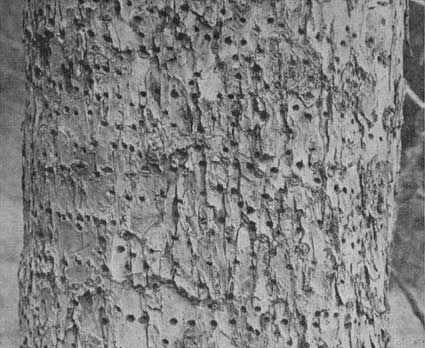|
Animal Life in the Yosemite
|

|
|
THE BIRDS WILLOW WOODPECKER. Dryobates pubescens turati (Malherbe) Field characters.—Smallest of our woodpeckers (pl. 5e) about halfway between junco and robin in size. Upper surface, wings and tail chiefly black; lower surface dull white; a white streak over eye, and one across forehead and down along cheek; middle of back continuously white (no bars); outer tail feathers white, barred with black; outer wing feathers marked with white spots near tips. Males have a bright red band across back of head, this, however, not often seen; females without any red at all. Flight-course in short undulations; wing strokes intermittent. Voice (seldom heard): A high-pitched run or trill of unique character. Occurrence.—Sparse resident of deciduous timber in Lower and Upper Sonoran and Transition zones. Observed from river bottom near Snelling to as high as 5750 feet on Yosemite Falls trail above foot of upper Yosemite Falls. Works chiefly on soft-barked deciduous trees such as willow, cottonwood, and apple. The Willow Woodpecker, a close relative of the eastern Downy Woodpecker, is nowhere abundant in the Yosemite region; in fact scarcely a dozen individuals all told were observed by our party during the entire period of our field work there. In coloration and general behavior the Willow Woodpecker resembles closely the much larger Modoc Woodpecker (see pl. 5), but it is far less noisy. It rarely has anything to do with coniferous trees, foraging, rather, on soft-barked trees such as the willow, cottonwood, and, where it is available about ranches, upon the apple. The quietness of the Willow Woodpecker, as compared with most other species in its family, is noteworthy. We heard no single call note from it, and only at long intervals did we hear the indescribable short trill characteristic of this bird. Individuals are much restricted in range, foraging along a relatively short line of cottonwoods or willows day after day. Once a bird is located, it can usually be found in the same place regularly. When foraging it moves about with very little commotion, and even when drilling for insects works so quietly that only a keen auditor can detect its presence. No matter what the season of the year, a pair of these birds is to be found usually within hearing of each other. The bird's close adherence to deciduous trees makes it more conspicuous and easier to observe in late fall and winter than in the summertime when the trees are fully leaved out; but even in winter, our experience with the Willow Woodpecker led us to consider it about the most elusive of all the diurnal birds of the Yosemite region. We had always supposed that the rapid series of notes uttered by this species were given only by the adult male and hence constituted a sort of song. But on June 24, 1920, in Yosemite Valley a juvenile male was found, with his head out of a nest hole eight feet above the ground in a dead branch of a live willow, giving every few moments this very series of notes. The large crown patch of red on this bird established its age and sex clearly. There was every indication that the notes were being given as a food call. A pair of Willow Woodpeckers proved to be regular tenants of Curry's apple orchard on the floor of Yosemite Valley. They, or their ancestors, had evidently worked there for some years, with the result that most of the 150 trees in the orchard showed marks of their attention, and many of the trunks were fairly riddled with drillings somewhat like those of the sapsucker. On November 8, 1915, two of us made a study of the site, with the following results. A measured area 6 inches (15 cm.) square, 4 feet (130 cm.) above ground on a trunk 12-1/2 inches (32 cm.) in diameter contained 17 fresh pits and 30 old ones, of last year's or older digging. These pits (fig. 41) were horizontally elliptical, each about 2.5 by 4 mm. in surface extent, and therefore were distinctly different in size and shape from true sapsucker drillings. They were arranged in irregular horizontal rows with spaces of 6 to 14 mm. between individual pits and 3 to 8 cm. between rows. On this particular trunk, the pits occurred over a vertical distance of 41 inches (105 cm.), so that there were about 2100 pits in all on this one tree. Limbs less than 4 inches (10 cm.) in diameter usually had not been worked upon. However destructive this drilling may seem to be, it does not seriously affect the vitality of the trees; the pits are but 4 to 5 mm. deep, penetrating only those outer layers of the bark which after a time scale off. We should judge that all evidence of this woodpecker's work is thus removed through natural process within about three years. The heartwood of the tree therefore seems not to be damaged at all by the woodpecker's work; it is damaged, however, by the work of the true sapsucker.
Our inference from these facts is that the Willow Woodpecker feeds on the inner layers of bark, which the bird exposes through the perforations described above. We watched a bird at work; moreover, bits of inner bark-fibers were found adhering to the bristles around the bill of a bird shot. |
| <<< PREVIOUS | CONTENTS | NEXT >>> |
Animal Life in the Yosemite ©1924, University of California Press Museum of Vertebrate Zoology grinnell/birds62.htm — 19-Jan-2006 | ||
